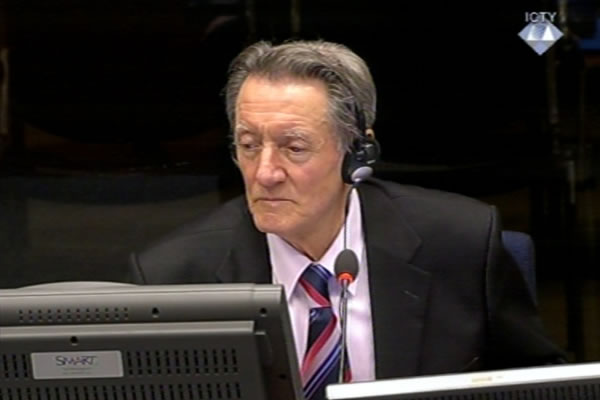Home
GENERAL MILOSEVIC AND TRAMS IN SARAJEVO
Radovan Karadzic’s defense witness, former commander of the Sarajevo-Romanija Corps, contends that the BH authorities and the BH Army were responsible for the fact that the Bosnian Serb army bullets sometimes ‘accidentally hit’ Sarajevo trams. The witness admitted that in some situations some ‘deranged people on the Serb side’ may have fired on the civilians in the city
 Dragomir Milosevic, defence witness of Radovan Karadzic
Dragomir Milosevic, defence witness of Radovan Karadzic The last day of General Dragomir Milosevic’s cross-examination was partly dedicated to the suffering of the citizens in Sarajevo at the hands of the snipers. Milosevic was called by the former Republika Srpska president Radovan Karadzic to testify in his defense. Prosecutor Edgerton noted that the Sarajevo-Romanija Corps was responsible for those crimes, and the witness strenuously denied it. General Milosevic commanded the corps from the summer of 1994 to the end of 1995.
As he was examined by Karadzic last week, Milosevic claimed that his corps never targeted Sarajevo civilians. This prompted the prosecutor to confront Milosevic with the evidence from the previous trials, which shows that snipers operating from Serb positions killed 336 and wounded 1,789 civilians from 1992 to 1994. This, in the prosecutor’s opinion, supports the conclusion that the Serb side terrorized civilians and created a situation in which they felt ‘trapped, under pressure and scared’. The general replied that the data referred to the period before he assumed command. Nevertheless, the witness insisted that his corps ‘wasn’t arrogant’ and denied that civilians were fired at.
Asked who was responsible for the deaths and injuries of so many people, the witness replied that he ‘cannot rule out the possibility’ that the perpetrators were in the ranks of the BH Army. According to Milosevic, they ‘caused casualties either inadvertently or on purpose’ to create an atmosphere in which they were the vulnerable side. Milosevic also conceded that in some situations some ‘deranged people on the Serb side’ may have fired at civilians in the city. However, Milosevic insisted on his claim that they didn’t have orders to do that.
Numerous sniper attacks on Sarajevo trams are listed in the indictment against Karadzic, and in Milosevic’s judgment. Today the witness presented an elaborate theory to blame the other side for those incidents. According to this theory, first the authorities in Sarajevo persuaded the citizens that it was safe to use public transport. The BH Army then opened fire on the Serb positions in the area where trams crammed with people ran. As the Sarajevo-Romanija Corps returned fire, a bullet or two may have ‘accidentally hit a tram’.
Concerned that he had not been persuasive enough, the general said it was ‘difficult to explain the entire situation’ to those who ‘have no idea’ what combat operations look like. If the prosecutor only knew ‘what is going on in combat, what type of fire is used and in what direction’, she would understand that ‘many bullets don’t actually go where they are aimed’ and they presumably end up hitting a tram.
At the beginning of the cross-examination, the prosecutor revisited the issue that was raised yesterday: the shelling of the Hrasnica neighborhood in Sarajevo on 7 April 1995 on Milosevic’s order of the previous day. The witness claimed that the objective of the attack was to neutralize the enemy mortars located in the ‘park area’. The prosecutor noted that one of Milosevic’s subordinates, the Ilidza Brigade commander Vladimir Radojcic, had countered Milosevic’s claim. When he testified in Karadzic’s defense, Radojcic said that the target had been the post office building where a BH Army brigade had its headquarters. Radojcic didn’t mention any mortars in the park. General Milosevic replied that Radojcic may have suffered ‘memory loss’ and stuck to his previous claims.
The witness was asked why he didn’t mention mortars as targets in the order but ordered an attack on the ‘most profitable targets where the greatest casualties and physical damage would be inflicted’. He replied there was no need to do that because the officers to whom the document was sent ‘knew what to shell’. A woman was killed in her family home when an air bomb launched from a modified launcher on the ground hit the center of the settlement; three persons were wounded. General Milosevic dismissed the suggestion that modified air bombs were extremely inaccurate. He remained adamant even when he was shown a document drafted by one of his subordinate officers, who demanded that air bombs not be fired on the entrance of the tunnel underneath the Butmir airport. Because the air bombs were so inaccurate, the officer stated in the document, there was danger that such a bomb could hit the Serb positions located as far as 500 meters from the entrance.
As the hearing drew to a close, Karadzic began re-examining his witness.
Linked Reports
- Case : Karadzic
- 2013-02-04 SARAJEVO WOULD HAVE BEEN ‘ASHES AND DUST’ HAD IT NOT BEEN FOR GENERAL MILOSEVIC
- 2013-01-31 “TYING FLAGS” AGAINST SERBS
- 2013-01-29 GENERAL PRAISES HIS CORPS
- 2013-02-06 'PSYCHOSIS’ IN COURT
- 2013-02-07 ‘EAGLE’ VERSUS ‘LARKS’
- 2013-02-07 GENERAL KRSTIC REFUSES TO TESTIFY IN KARADZIC’S DEFENSE
